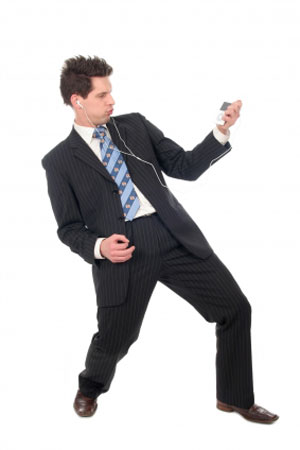Are iPods Damaging Our Ears? Answer is Hard to Hear

New studies are challenging the link between personal MP3 players and hearing loss among adolescents.
No scientist doubts that loud noise can damage our ears, but it's unclear if our ears are any worse off today than they were before the original cassette-playing Sony Walkman debuted more than 30 years ago.
Nevertheless, the Journal of the American Medical Association (JAMA) sounded a bad note for MP3 players in mid-August, when it published a study that found hearing loss amongst United States adolescents age 12 to 19 had shot up from 14.9 percent to 19.5 percent since about 1990.
Although the JAMA study was not designed to tease out a mechanism for this apparent spike, its authors pointed to other recent studies that implicated portable music devices for the sonic deficit.
"From the sheer volume of studies out there, [the most likely cause for this rise in hearing loss] would probably be music devices," said Josef Shargorodsky, lead author of the JAMA study and an otolaryngologist at Harvard Medical School's Massachusetts Eye and Ear Infirmary. "There's definitely cause for concern."
In an Australian study published this year and cited by the JAMA piece, the use of personal music-playing gadgets was associated with a 70 percent increased risk of slight to mild hearing loss in a sampling of several thousand elementary school students.
A recent editorial in the British Medical Journal reviews the reasons why this is possible. Surveys have shown that some 90 percent of young people in the U.S. and Europe use portable MP3 players and listen to them for hours a day at full volume.
Get the world’s most fascinating discoveries delivered straight to your inbox.
These listening habits, coupled with the adoption of ear buds, bombard sensitive auditory organs with the aural equivalent of standing on an airport runway.
Devices "increasingly use earphones that insert into the ear canal, which produce higher sound levels in the ear than 'over the ear earphones' used at the same volume," wrote Peter Rabinowitz, an associate professor of medicine at the Yale University School of Medicine. "These sound levels can exceed 120 decibels, similar in intensity to a jet engine."
Sound and fury, signifying nothing?
Yet one researcher has questioned the validity of the JAMA findings, chalking up as much as 10 percent of the claimed hearing deficits to measurement errors.
"It's disappointing for me right now that some people are treating the JAMA study as if we are on the verge of an epidemic [of hearing loss caused by loud noise]. I don’t believe the evidence supports that," said Robert Schlauch, lead author of a new study in the Journal of Speech, Language and Hearing Research and a professor at the University of Minnesota's department of speech language hearing sciences.
Schlauch and a colleague recently ran computer simulations on the statistics of the hearing tests referenced in the JAMA study – those hear-a-tone-in-your-right-ear, raise-your-right-hand-style evaluations many of us experienced as grade schoolers.
The JAMA study compared such hearing test data in national surveys that were conducted between 1988 and 1994 and from 2005 to 2006.
Schlauch's simulations, when compared to the first data set, yielded a lot of "false positives" – children being identified as having lost some hearing ability when in fact their auditory perception was normal.
Schlauch cited issues with equipment calibration and natural human hearing variability at the tested frequencies – not to mention occasional earwax buildup – for many of the false alarms.
I can hear clearly now
To further prove the point, in a recently completed though as-yet-unpublished study, Schlauch and his colleagues tested the hearing of the approximately 350-member University of Minnesota marching band. Around 15 percent of band members demonstrated some degree of hearing loss initially.
But when tested repeatedly over the course of a year, and with their results averaged, over half of the band members' apparently noise-induced hearing gaps vanished.
Findings such as these show that a single test is just a snapshot of someone's hearing ability, Schlauch said. Multiple tests and case histories are often needed to diagnose genuine hearing loss, he added.
Sing into my good ear
As for the theory that personal music players are behind noise-induced hearing loss, Schlauch said that the preponderance of unilateral, or one-sided hearing losses in the sourced JAMA data set makes this connection look shaky at best.
Hearing a song in stereo would cause similar hearing dips in both ears rather than, say, firing a rifle, which would expose the closer ear to more aural damage.
Schlauch thinks that many of these detected one-sided hearing losses are in fact measurement errors, especially considering that those children tested did not have any risk factors (for example, they did not work in loud factories, nor serve as riflemen).
Stay tuned
To serve up the point that different studies can tell very different stories, another paper published earlier this year in Ear and Hearing ran with the title "Americans Hear as Well or Better Today Compared With 40 Years Ago," finding evidence that standard tested high frequencies are apprehended better nowadays.
At any rate, Harvard's Shargorodsky and Schlauch do see eye-to-eye (or hear ear-to-ear) when it comes to iPod users practicing some good ear health by not blaring music at full blast.
"The goal is ultimately to try to find preventable causes of hearing loss," said Shargorodsky. "If its noise, and that’s reason for this rise, we need to be more careful about how our kids are exposed to loud noise."
Schlauch remains unconvinced that the sounds generated by today's MP3 players are on the whole doing any more harm than the Sony Walkman and Discman that had their heyday in the 1980s and 1990s.
Naturally, noise-induced hearing loss caused by those once-new-fangled gadgets was a "big concern back then, too," Schlauch noted. • MP3 Player Reviews • Apple Announces New Line of iPods, Not Bigger but Better • Top 10 Disruptive Technologies



